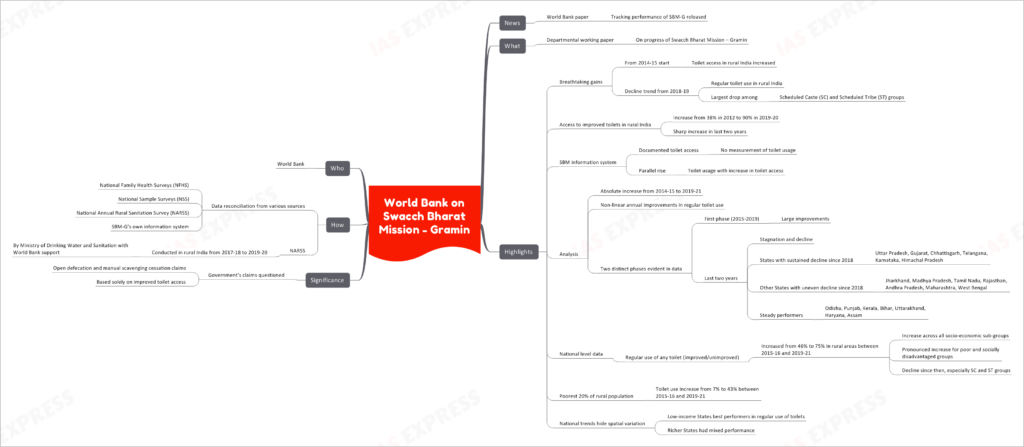World Bank on Swacch Bharat Mission – Gramin

The World Bank has released a departmental working paper that meticulously tracks the performance of the Swacch Bharat Mission – Gramin (SBM-G). This paper scrutinizes the progress of SBM-G and raises important questions regarding the government’s claims about open defecation cessation and the eradication of manual scavenging.
Understanding the Essence
SBM-G in Focus
The departmental working paper delves deep into the heart of the Swacch Bharat Mission – Gramin (SBM-G) to assess its impact and trajectory.
Noteworthy Gains
From its inception in 2014-15, SBM-G achieved remarkable gains in terms of toilet access in rural India. However, the data reveals a decline trend that emerged from 2018-19 onwards, particularly concerning the regular use of toilets in rural areas. This decline is most pronounced among the Scheduled Caste (SC) and Scheduled Tribe (ST) groups.
Soaring Toilet Access
The report showcases a substantial increase in access to improved toilets in rural India, surging from 38% in 2012 to an impressive 90% in 2019-20. This surge in access has been especially prominent in the last two years.
SBM Information System
The SBM information system plays a pivotal role in documenting toilet access. However, it is important to note that this system does not measure toilet usage. Intriguingly, the data suggests a parallel rise in toilet usage along with the increase in toilet access.
Data Analysis
The report conducts a comprehensive analysis, examining the absolute increase in SBM-G progress from 2014-15 to 2019-21. It identifies non-linear annual improvements in regular toilet use and identifies two distinct phases in the data:
- First Phase (2015-2019): During this period, large improvements were observed.
- Last Two Years: In contrast, the data shows stagnation and decline, particularly in states like Uttar Pradesh, Gujarat, Chhattisgarh, Telangana, Karnataka, and Himachal Pradesh. Other states also exhibited uneven declines since 2018, including Jharkhand, Madhya Pradesh, Tamil Nadu, Rajasthan, Andhra Pradesh, Maharashtra, and West Bengal. However, some states like Odisha, Punjab, Kerala, Bihar, Uttarakhand, Haryana, and Assam maintained steady performance.
National-Level Trends
At the national level, data indicates that the regular use of any toilet (improved/unimproved) increased from 46% to 75% in rural areas between 2015-16 and 2019-21. This increase cut across all socio-economic sub-groups, with a particularly pronounced rise among the poor and socially disadvantaged groups. However, there has been a decline since then, especially among the SC and ST groups.
Bridging the Gap
The poorest 20% of the rural population experienced a significant increase in toilet use, rising from a mere 7% to an encouraging 43% between 2015-16 and 2019-21.
Spatial Variations
The report underscores the importance of recognizing spatial variation in the SBM-G’s performance. Interestingly, low-income states have emerged as the best performers in terms of regular toilet use, while richer states displayed mixed results.
The Significance
The departmental working paper raises important questions about the government’s claims regarding the cessation of open defecation and manual scavenging. These claims are primarily based on improved toilet access, and the report highlights the need for a more comprehensive assessment that includes toilet usage.
Unraveling the Data
The assessment involved data reconciliation from various sources, including the National Family Health Surveys (NFHS), National Sample Surveys (NSS), National Annual Rural Sanitation Survey (NARSS), and SBM-G’s own information system. Notably, the NARSS, conducted in rural India from 2017-18 to 2019-20 with World Bank support, played a crucial role in gathering key data.
The World Bank’s Role
The World Bank, in collaboration with the Ministry of Drinking Water and Sanitation, has been instrumental in conducting this assessment and shedding light on the performance and challenges of SBM-G.
If you like this post, please share your feedback in the comments section below so that we will upload more posts like this.

